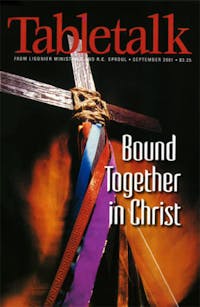
Request your free, three-month trial to Tabletalk magazine. You’ll receive the print issue monthly and gain immediate digital access to decades of archives. This trial is risk-free. No credit card required.
Try Tabletalk NowAlready receive Tabletalk magazine every month?
Verify your email address to gain unlimited access.
The Christian faith is called a “faith” in part because at its core it is confessional. By confessional I do not mean that it acknowledges sins (which, of course, it does), but that it declares affirmations of belief before the world. Christianity is a religion with a content, a body of truths that are embraced and professed. We are distinguished by what we believe.
It sometimes seems that people think the Christian church was born in the twentieth century. The driving force of much church activity today is to be “contemporary” in style, in worship, and in theology. We have witnessed not a mere alteration in style, but a revolution. The church’s architecture has changed from the Gothic or Georgian styles, which sought to communicate the transcendence of God, to that of a civic meeting house and now to a secular odium. Gone is the organ, the chancel, the choir, and the pulpit. These anachronisms are replaced by the synthesizer, the stage, the worship team, and the translucent plastic lectern, which often is removed to make room for the drama team. Stained glass has given way to colored lights that change the ambiance of the stage from chancel to cabaret.
The new worship style is designed for and directed to the unbeliever in an effort to be relevant and to meet postmodern people where they are. The thought seems to be that if the world will not welcome the church into its midst, perhaps the church can welcome the world into its midst. However, it appears to me that this revolution, despite its well-intentioned motives of outreach, is nothing less than the secularization of the church. We are, as the late James M. Boice said, “Doing the Lord’s work in the world’s way.”
I am aware that there is nothing sacrosanct about pipe organs, stained glass, pulpits, pews, and chancels. The early church thrived in the catacombs without the benefit of these accouterments. And we know that traditional church architecture and worship haven’t been “working” everywhere. Magnificent cathedrals in Europe have become museums of the past that antedate the “post-Christian era”—or mausoleums for the death of God.
Since the world has rejected the church in its more traditional forms, it is not surprising that zeal for evangelism has turned to experimental forms and styles, that the Gospel message might get through. The church expresses its faith in different forms and styles in different ages and cultures. As cultures change, so does the style of the church.
However, changes in the church’s style sometimes are driven by a degrading culture. In our day, it has begun with an addition, leading to a subtraction.
The secular culture has embraced the philosophers of pluralism and relativism, the twin pillars of the larger topic of secularism. Since the world is accepting secularism, pluralism and relativism have been added to the church in an attempt to make it more “relevant.”
This leads to the current antipathy to theology. Doctrine is said to divide, while pluralism and relativism unite. Thus, it is assumed that if we are to enjoy the true communion of the saints, we must have done with creeds, since they only spark theological contention and division. Every creed affirms something and, by that affirmation, necessarily denies its opposite. All who are united by creeds are also divided from those who reject the content of those creeds.
I am reminded of the dispute that arose in the sixteenth century between Desiderius Erasmus and Martin Luther. In his Diatribe against Luther, Erasmus declared that he preferred to remain “open” on theological issues and make no assertions. This point almost gave Luther apoplexy. He replied that the making of assertions was the very mark of the Christian, and that if you take away assertions you take away Christianity. He reminded Erasmus that the Holy Spirit is not a skeptic and that the assertions He makes are more certain than life itself.
The communion we share with all who are in Christ is a communion not only in spirit but also in doctrine and in worship. We have one Lord, one faith, and one baptism. We have Christ, the Gospel, the Word, and the sacraments.
Throughout church history, Christians have insisted that the Word and the sacraments belong together. Sacraments without the Word become naked symbols. The Word without the sacraments becomes impoverished. Likewise, doctrine and worship can be distinguished but never separated.
I cannot help but wonder whether the revolution in worship today is driven more by the collapse of doctrine through the addition of secularism than by the fresh wind of the Holy Spirit blowing in our midst. The secular culture is hardly one that manifests the fruit of the Spirit. When the church starts to look identical to a dying culture, we must wonder who is influencing whom.
The great myth of our day is the myth of influence, which declares that if we are to influence the culture we must build bridges to it by adopting its methods and styles. But the lesson of history is that, in this game, the world always wins and the church always loses. The church only wins when it keeps the faith—maintains its creed and becomes transformed rather than conformed to the world.
